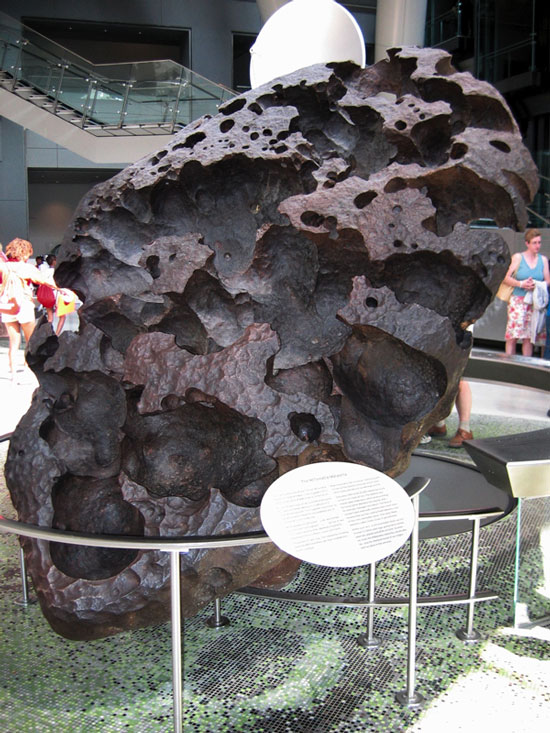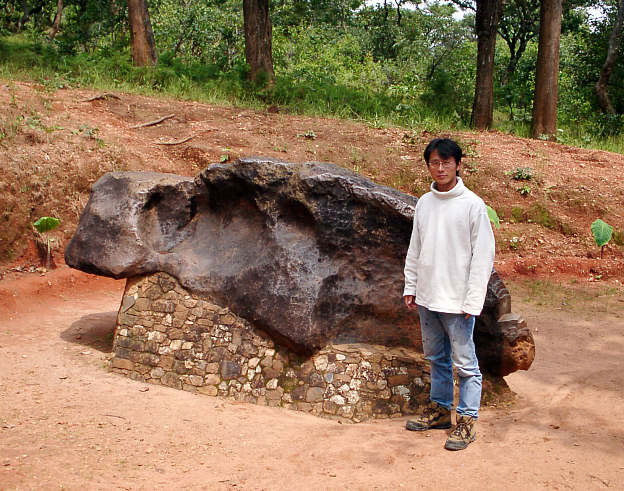The surface of the 'giant' meteorite landed on Earth
Like refugees on their way to escape from distant solar systems, meteorites rush through the Earth's atmosphere and fall on our planet.
Normally, these fireballs of metal and rock will ignite stunts and many of them will not 'survive' through the collision with the Earth's surface. The few meteorites that survive will begin to settle in new lands, withstand the erosion of time and climate over hundreds or even thousands of years.
Let's face the 7 single meteors that are rated to be the largest ever landing on Earth in ascending order:
Willamette meteorite (USA), heavy: 15.5 tons

With an area of 7.8 square meters and weighing 15.5 tons, Willamette is the largest meteorite ever found in America. The analysis showed that this meteorite consists of 91% iron and 7.62% nickel. There is no longer any trace of its impact on the ground at the initial landing in the state of Oregon.
Although very popular with American aboriginals (and believing it needs to be returned to the original place), the discovery of the modern Willamette meteorite is counted for an immigrant named Ellis Hughes in 1902. Finding the precious stone, Hughes spent three months working hard to move the meteorite out of Oregon's Iron and Steel owned land to declare it his. However, Hughes was arrested. The meteorite later sold for $ 26,000 and was put on display at the American Museum of Natural History.
Mbosi meteorite (Tanzania), weighs 16 tons

Officially discovered in 1930 (although at the time it was considered by the native inhabitants as a holy rock), Mbosi was a giant meteorite in Tanzania. It is actually an estimated space metal weighing up to 16 tons. As is the case with many other meteors, Mbosi's place has no dents of impact. That may be explained, meteorites have rolled away after landing on the surface of the Earth or simply have been here for thousands of years.
Back in 1930, Mbosi was half-submerged under the ground. Currently, the earth around the meteorite has been dug and a base is built below it, although the original position remains the same.
Agpalilik meteorite (Greenland), weighing 20 tons

Vagn F. Buchwald discovered in 1963, Agpalilik is the fourth largest platform separated from Cape York meteorite in Greenland. This unpretentious meteorite (estimated at 20 tons) is on display at the Geological Museum in Copenhagen, Denmark.
The Cape York meteorite - the 'mother' of Agpalilik - crashed into Earth nearly 10,000 years ago and is one of the largest iron meteorites that ever landed on our planet. Over the centuries, the indigenous Inuit - one of the oldest people in the world, has taken advantage of the meteorite stripped from Cape York as a plentiful supply of metal to make tools and weapons. The story of the existence of a strange iron mine until 1818 only reached the ears of scientists. From 1818 to 1883 there were five expeditions to find that abundant iron mine but all failed.
Bacubirito meteorite (Mexico), weighing 22 tons

Bacubirito is undoubtedly the most 'massive' meteorite in Mexico and one of the largest celestial bodies surviving a collision with Earth. With an estimated weight of 22 tons, this 4 meter long curving iron is currently on display at Centro de Ciencias de Sinaloa in Culiacan.
Bacubirito was discovered in 1892 by American geologist Gilbert Ellis Bailey during a Central and South American tour under the Interocean magazine's coverage. Mr. Bailey unearthed a massive meteorite with the help of local residents. Like other meteors, Bacubirito is named after the place where it was found.
The Ahnighito (Greenland) Meteorite, weighing 31 tons

Ahnighito - the largest piece separated from Cape York 'mother' meteorite weighs 31 tons and is the heaviest meteorite that humans have ever moved. Rumors of the Greenland iron mine came to scientists from 1818, but it was not until 1894 that American explorer Robert E Peary finally found its exact location, with the support of a Anonymous local guide.
It took three years for Peary to find a way to move the meteorite into the boat, regardless of the construction of the only railway in Greenland and the valuable help of the Inuit. However, the adventurous explorer finally managed to sell meteorites to the American Museum of Natural History for $ 40,000. In keeping with the display, the museum has built a base to support the 'massive' meteorite area of 12.1m 2 .
El Chaco meteorite (Argentina), weighs 37 tons

El Chaco is the largest piece of 'mother' meteorite that has been broken to form a meteorite field up to 60km 2 in Argentina. This is the second heaviest single meteorite ever found on Earth.
El Chaco was officially discovered in 1969 at a depth of 5 meters thanks to a metal detector, although information about the pit surrounding it has been obtained since 1576 and local aboriginal people are also very thorough about the place. Another sensational episode is that, in 1990, an Argentinian police broke the plot to steal El Chaco from a meteorite hunter named Robert Haag.
Hoba meteorite (Namibia), heavy: 60 tons

Head to the list of 'massive' meteorites that land on Earth as Namibia's Hoba. Although only occupying an area of more than 6.5m 2 , this meteorite weighs up to 60 tons. It is believed to have slowed the flight speed by the Earth's atmosphere, but that speed is still large enough for the meteorite to remain intact and almost buried when it falls to the Earth's surface. Experts also said that irregular shape also helps meteorite roll away.
Supposedly landed on Earth nearly 80,000 years ago, the Hoba meteorite consists of about 84% iron and 16% nickel. It is still considered the largest natural iron on the surface of the Earth.
Due to its 'massive' size, the Hoba meteorite has never been displaced from its original landing since a farmer discovered it during plowing in 1920. Currently, each year, Hoba attracts thousands of visitors. visitors come to admire it.
- A giant meteorite just flew over Earth
- NASA says a giant meteorite will fly over the Earth in the next 48 hours
- Close up of meteorite burning like a fireball falling in Australia
- A meteorite as big as the Great Pyramid is about to fly over the Earth
- The 50m meteorite may crash into Earth later this year
- A giant meteorite is rushing to Earth
- NASA speaks about meteorites larger than the Great Pyramid rushing to Earth
- Giant meteors are about to fly through the earth
- Giant meteors are about to fly across Earth
- Monitor the risk of collisions between giant meteorites and Earth
- Giant meteorite approached the Earth at midnight on September 7
- Huge meteorites make the Earth hot to 2,300 degrees Celsius
 Van Allen's belt and evidence that the Apollo 11 mission to the Moon was myth
Van Allen's belt and evidence that the Apollo 11 mission to the Moon was myth The levels of civilization in the universe (Kardashev scale)
The levels of civilization in the universe (Kardashev scale) Today Mars, the sun and the Earth are aligned
Today Mars, the sun and the Earth are aligned The Amazon owner announced a secret plan to build a space base for thousands of people
The Amazon owner announced a secret plan to build a space base for thousands of people